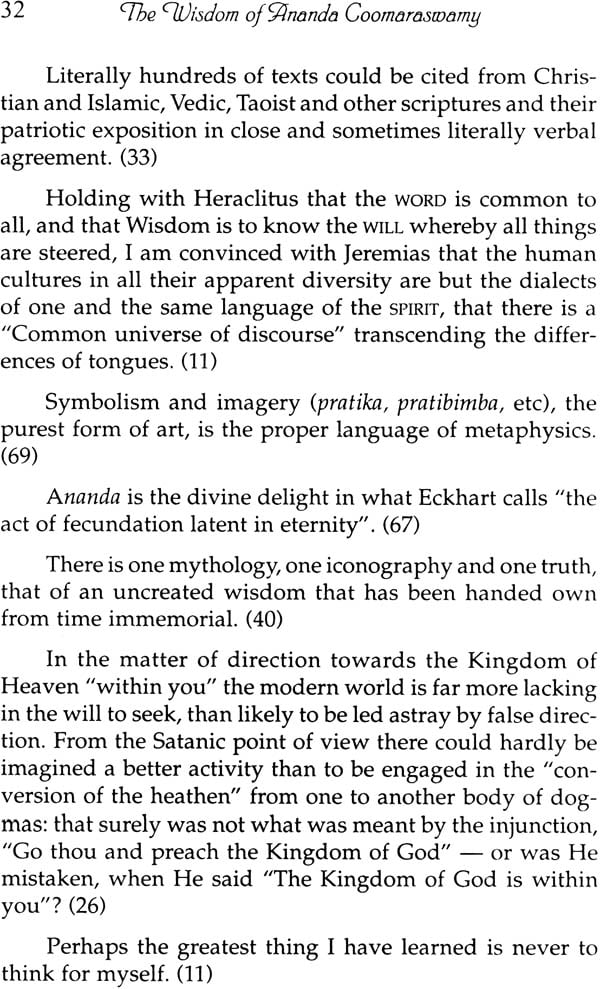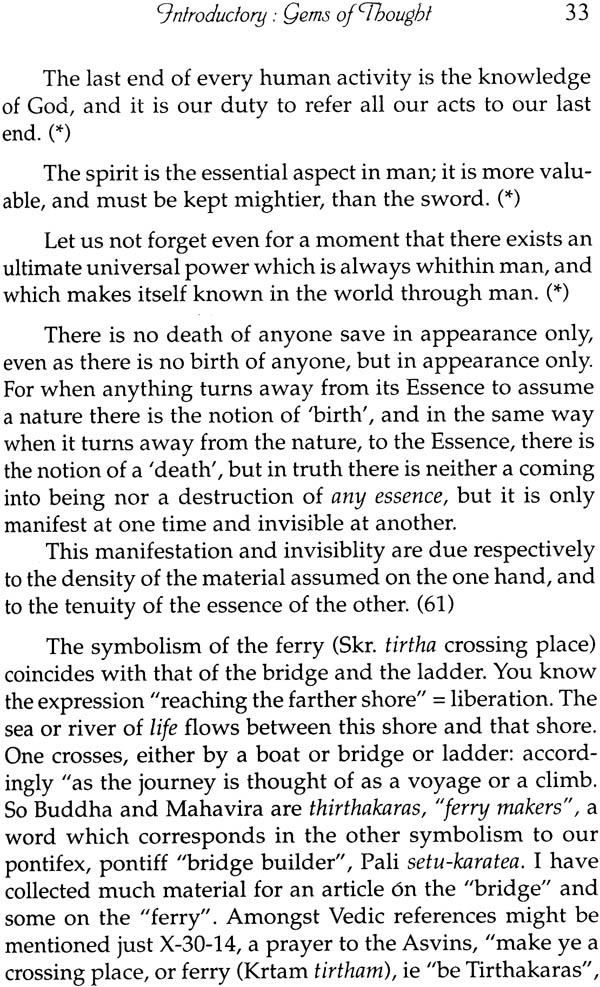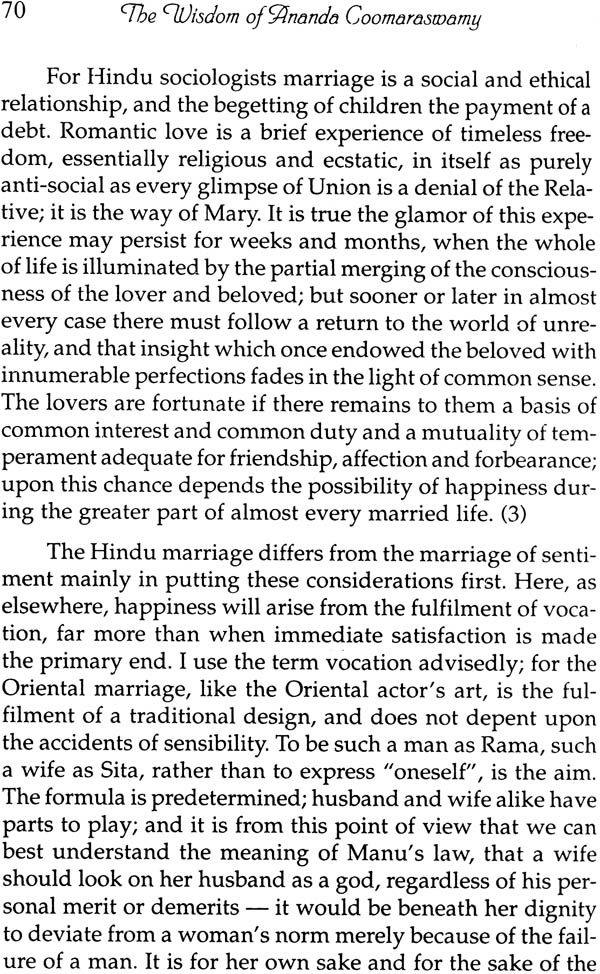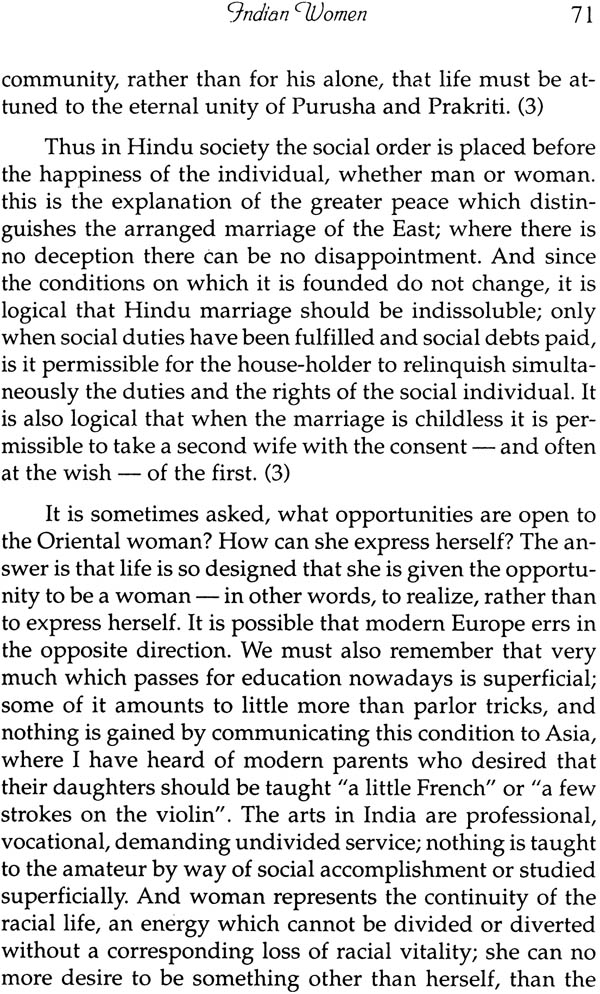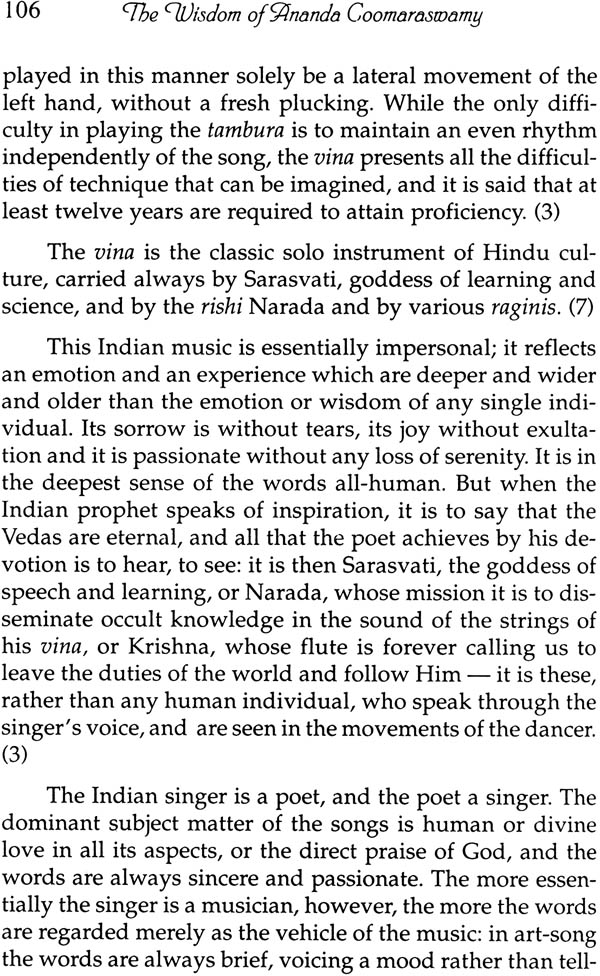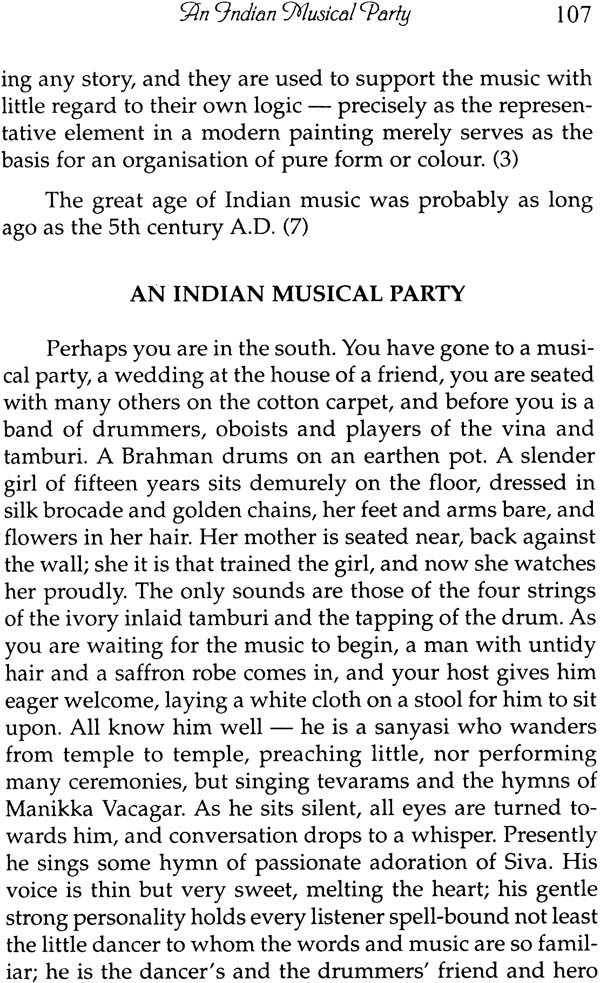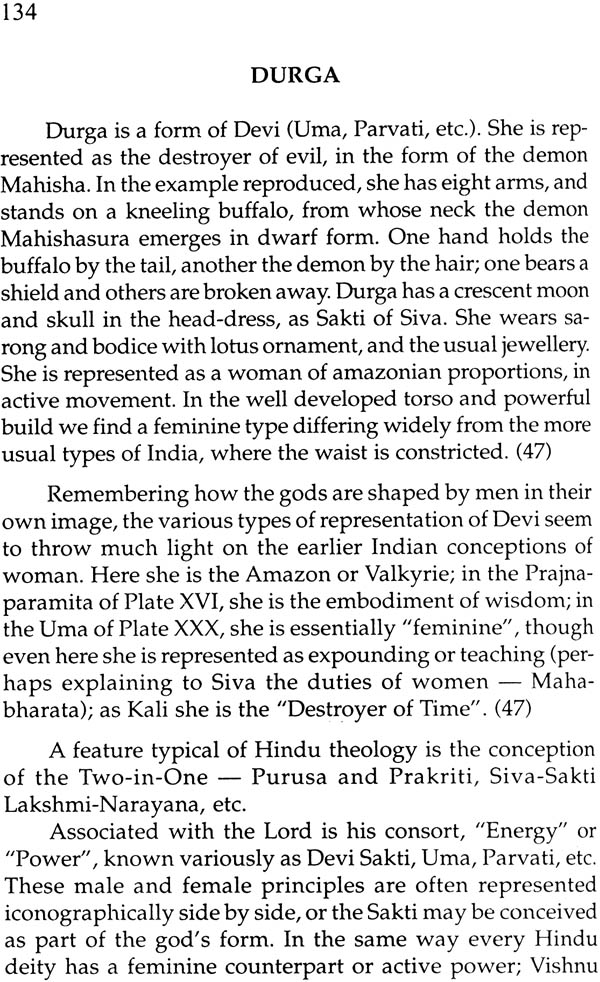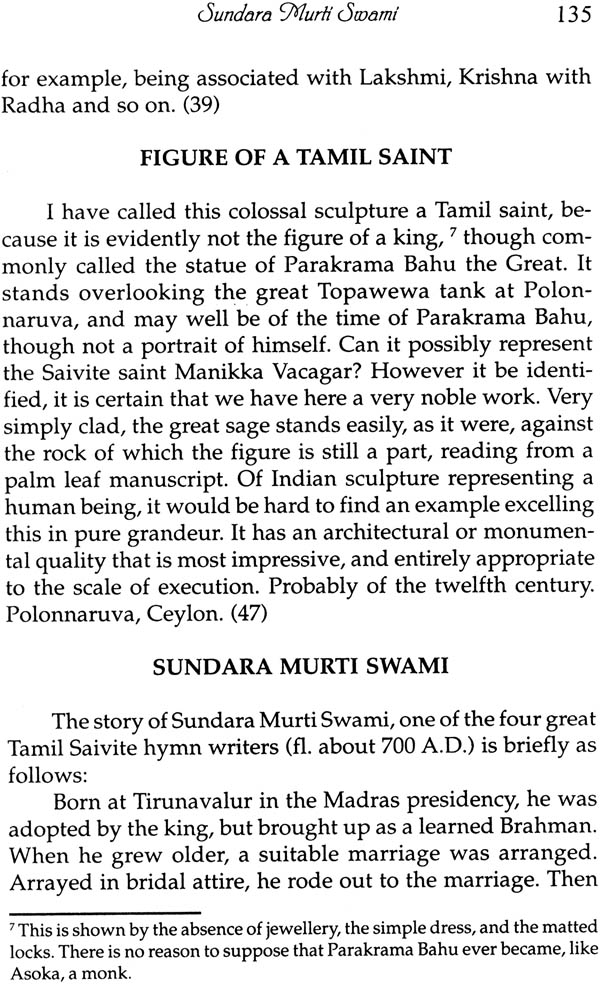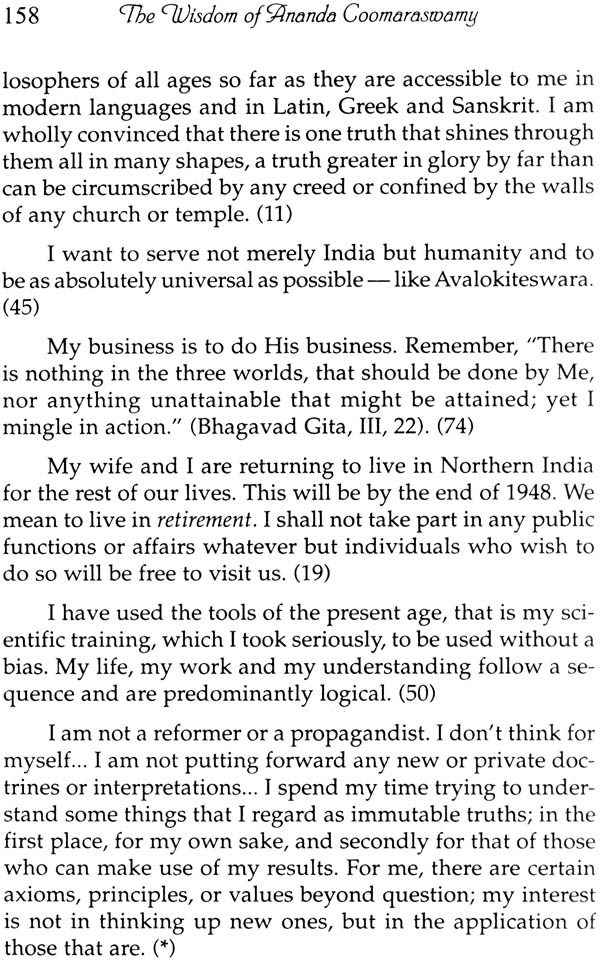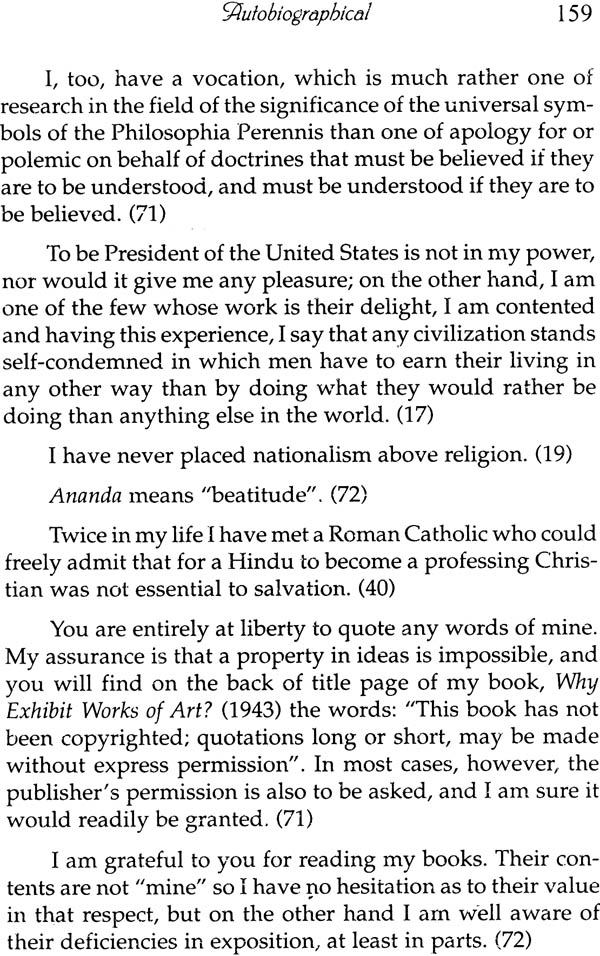
The Wisdom of Ananda Coomaraswamy (Great Thoughts Selected from his writings, letters and speeches)
Book Specification
| Item Code: | IDD712 |
| Author: | S. Durai Raja Singam |
| Publisher: | Indica Books, Varanasi |
| Language: | English |
| Edition: | 2001 |
| ISBN: | 8186569219 |
| Pages: | 170 |
| Cover: | Paperback |
| Other Details | 7.2" X 4.8" |
| Weight | 180 gm |
Book Description
Ananda Kentish Coomaraswamy (1987-1947) was one of the best minds that India has produced in the 20th Century. Son of a Tamil father and an English mother, his life was a living example on how to build bridges between Eastern and Western cultures.
By profession an art critic and a museum curator, Ananda K.Coomaraswamy was also masterful exponent of metaphysics. As much at home with Plato, Aristole and Aquinas as with Shankara and the other Vedic commentators, familiar with Scriptures of all the main religions and proficient in many languages, he used to teach metaphysical principles by explaining the symbolism of traditional works. In his writing coomaraswamy never display his vast knowledge for the sake of mere erudition, but rather uses his amazing scholarship for a well crafted plan: to show that below the endless variety of art forms and traditional beliefs a common thread runs deep -the acceptance of the sacred as the ultimate means to validate the multiplicity of every day experience.
This book is a compilation of quotations from his works and letters, and it constitutes a good introduction to his thought. His theories are here applied to concrete situations, related to the problems of modern India, and could still suggest a third way to avoid both the traps of modern technocracy and the temptation of fundamentalism. It should not surprise us that his views are still relevant to the present situation: his opinions are rooted in truths that are neither political nor historical, neither ideological, or simply religious, nor even merely intellectual. They are rather related to that inner wisdom that embraces, without crushing it, all the distinctiveness of human experience.
One often speaks of the "Greek miracle"; but who ever hears of the miracle of Hinduism, this extraordinary amal- gam of Proto-Australoid, Mongolian, Negrito, and notably Dravidian and Aryan cultures anciently established on the Indian sub-continent, that flowered at some cyclical moment prior to recorded history into the brilliant homogeneous spiritual-socio-ethnic system we still know today, and whose essence is the Sanatana Dharma or perpetual Veda? Travel- ling in India at the beginning of the Christian era, Apollonius of Tyana found that "Pythagoras was anticipated by the In- dians". Yet Pythagoras himself antedated the Hellenistic period in question, which so far from being "miraculous" was more truly a waning segment of the Aryan tradition, and which in unison with Roman culture was to father that humanism whose post-Christian and "posthumous ven- geance"- in the words of Frithjof Schuon - erupted as the European Renaissance with its civilizationist aberrations culminating in the materialistic, relativistic, and tamasic anomalies of our century. This, then, is the background against which Ananda K. Coomaraswamy has so tellingly raised his voice and witness. Hindu sages proclaim that the eternal Veda will alone endure, being the universal substratum of all religious forms: and in this sense - as well as historically and geographi- cally - Hinduism is providentially situated as a sort of "axis" among world religions; and Coomaraswamy in his turn, given his profound intellectual substance and vision, has been admirably destined through his East-West origins to re-manifest this world-wide nature of the Sanatana Dharma. He brings the Indian heritage to the West, while pointing the West back to her own traditional birthright - Christian and pre-Christian; and the universality of this out- look enables him to draw on "all orthodox sources what- ever" of the Philosophia Perennis to compose a unified world picture of the "normal" order of things, which is the pre- rogative of no one single people or religion anywhere.
These present extracts of Coomaraswamy's writings, chosen from the heart and judiciously arranged by Sri S. Durai Raja Singam, serve beyond the immediate merit of their didactic message a twofold purpose: they reveal inti- mate facets of the more personal side of Coomaraswamy; we behold the "structure" of his own thoughts and attitudes and aspirations; we see the man behind the Doctor. And secondly, one cannot fail to hear an appeal of urgent con- cern - a crucial call to India to remain Indian.
For in the quarter of a century since his death, the rav- ages he foresaw have devastatingly increased on a global scale; and although one may demur before Professor AK. Saran's pronouncement that "today there is no living Hindu society in India", nevertheless how many contemporary Hin- dus could pass muster by the criterion of K.Y. Rangaswami Aiyangar: "He who rejects Dharmasastra, especially where its dicta rest on Vedic sanction, is not therefore a Hindu"? And Coomaraswamy would certainly be the first to endorse the words of Sri Chandrasekhara Bharati Swamigal, the late Sankaracharya of Sringeri: " It is well known that people everywhere are now suffering. It can be confidently asserted that this suffering dates from their giving up the courses of conduct observed by their ancestors. When the practice of Dharma began to decline, suffering began."
It must be stressed that Comaraswamy's love for India transcended any political or nationalistic bias, and was based on a veneration for the sacred and the noble in a form that has a genius for translating first principles into scriptures and art patterns haunting in their beauty. I knew the Doctor at the time when India was just gaining independence. He could attend rallies with no taint of "patriotism", as he told me, since any nationalistic fervour had long since ceded to the contemptus mundi of his spiritual detachment - he who had truly learned to find himself, " 'in place' anywhere, and 'at home' everywhere - in the profoundest sense, a citizen of the world".
It is not hard to see from the allusion to beauty just above, how the genius in the tradition fired the genius in the sage with an impassioned love for art forms, which ex- tended to the principles of art in all traditions. It took Coomaraswamy's acid pen to quash modern society's nar- cissistic infatuation with "art for art's sake" through the so- bering mise au point that "the artist is not a special kind of man, but every man a special kind of artist". Images (icons), he tells us, are not made to be seen (exhibited) but realized; thus originally they were not "works of art" but "means (sadhana) of edification". Hence "an image will not repre- sent a moment of time, but a condition of being" (and if we evaluate much contemporary "art" by this criterion, we see that this "condition of being" more often than not is a patho- logical concatenation of psychic fissures unmasking a waste- land of the soul). Only that is truly beautiful- and real- which accords with revealed and established canons and not with individual fancies!
This, then, is the Coomaraswamy that Sri Singam pre- sents to us, a portrait of the man shaped in the ardour of his own ideals, his intransigence regarding canons and prin- ciples of art, his deep love of and dedication to that true India which modernized Indians would so easily betray in their blind fascination with the West's shabby materialism, and his equally profound understanding of and respect for Platonism and mediaeval Christian culture - as part of the whole Universal perspective to which his heart really be- longed. But the stress on India makes this collection of ex- tracts particularly valuable for Indians - Hindus first of all, and Muslims by extension. And since India plays a cho- sen role among world faiths, we all - Buddhists, Chris- tians, Sikhs, [ainas, Taoists and the rest -, will be enabled to find that particular aspect of Coomaraswamy's message which best accords with our own predestined path.
| Title | Page no |
| Note on the original edition | 6 |
| Introduction by W.N. Perry | 9 |
| Coomaraswamy, Ananda Kentish | 13 |
| Ananda Kentish Coomaraswamy by S. Durai Raja Singam | 15 |
| Art and Life | 17 |
| Indian's Contribution to World Culture | 21 |
| The Wisdom of Coomaraswamy by S. Durai Raja Singam | 23 |
| Extracts from Fragmentary Notes for a Yale Univ. Lecture | 27 |
| Introductory: Gems of Thought | 31 |
| India and Ceylon | 41 |
| Education | 47 |
| India | 54 |
| Indian women | 63 |
| Anti-Nautch Movement | 75 |
| Sahaja | 76 |
| Folk arts | 78 |
| Swadeshi | 79 |
| Beauty | 85 |
| Art | 87 |
| Sculpture | 95 |
| Schools of Style of Indian Art | 97 |
| Rajput Painting | 99 |
| The Kangra School | 100 |
| Moghul Painting | 101 |
| Jaina Art | 102 |
| Persian Painting | 103 |
| Indian Colonial | 103 |
| Yakshas | 104 |
| Music | 105 |
| An Indian Musical Party | 107 |
| Jewellery | 111 |
| Folklore | 113 |
| Garlands | 114 |
| Costume & Ornament | 114 |
| Competition | 115 |
| Copyright | 115 |
| The Bhagavad Gita | 116 |
| Yoga | 120 |
| Religion | 121 |
| Hinduism and Buddhism | 122 |
| Reincarnation | 123 |
| Saiva Siddhanta | 124 |
| Dravidians | 125 |
| Siva's dance | 126 |
| Dance of Siva-Nataraja | 127 |
| Nataraja (Siva) | 129 |
| Shiva Ratri (Siva's Night) | 131 |
| Siva (Gangadhara) | 132 |
| Ganesha, Java | 133 |
| Durga | 134 |
| Figure of a Tamil Saint | 135 |
| Sundara Murti Swami | 135 |
| Pattini Devi | 137 |
| The Hindu Bronzes | 138 |
| Borobudur | 145 |
| Sri Ramakrishna | 146 |
| Sri Ramakrishna Maharishi | 147 |
| Sister Nivedita | 147 |
| Mahatma Gandhi | 148 |
| Rabindranath Tagore | 149 |
| Jawaharlal Nehru | 151 |
| Nandalal Bose | 151 |
| Uday Shankar | 152 |
| Vidyapati | 153 |
| Ravi Varma | 153 |
| Autobiographical | 155 |
| Finale | 161 |
| Key to Sources | 162 |
| Glossary of Some Indian word | 168 |
